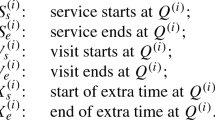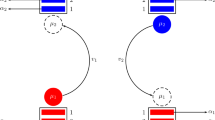Abstract
This paper examines the properties of single server queueing systems with customers of several types, where the server rotates its effort among the customer classes and serves all the customers that have accumulated for each class before moving on to the next. The paper shows that expressions for the first two moments of the queue lengths, and for the mean waiting times, can be developed from two simple properties of the arrival and service processes. The properties, which include existing models as special cases, seem plausible descriptors of the complex arrival and service processes that arise in the transportation field.
Similar content being viewed by others
References
W.H. Atkins, Modern marine terminal operations and management, The Port of Oakland, Oakland, CA (1983).
D.R. Cox,Renewal Theory (Methuen, London, 1962).
J.N. Darroch, G.F. Newell and R.W.J. Morris, Queues for a vehicle-actuated traffic light, Oper. Res. 12 (1964) 882–895.
M.J. Ferguson and Y.J. Aminetzah, Exact results for nonsymmetric token ring systems, IEEE Trans. Comm. COM-3 (1985) 223–231.
B. Gamse, An analysis of elevator operation in moderate height buildings, Ph.D. Thesis, Institute of Transportation Studies Dissertation series; UCB-ITS-DS-78-2, Univ. of California, Berkeley, CA (1978).
B. Gamse and G.F. Newell, An analysis of elevator operation in moderate height buildings-I: A single elevator, Trans. Res. B16 (1982) 303–319.
G.F. Newell, Properties of vehicle-actuated signals: I. One-way streets, Trans. Sci. 3 (1969) 30–52.
G.F. Newell,Applications of Queuing Theory, 2nd ed. (Chapman-Hall, London, England, 1982).
E.E. Osuna, Control strategies for idealized bus systems, Ph.D. Thesis, Institute of Transportation Studies Dissertation series; UCB-ITTE-DS-69-3, Univ. of California, Berkeley, CA (1969).
E.E. Osuna and G.F. Newell, Control strategies for an idealized public transportation system, Trans. Sci. 6 (1972) 52–72.
D. Sarkar and W.I. Zangwill, Expected waiting time for non-symmetric cyclic queueing systems — Exact results and applications, Man. Sci. 35 (1989) 1463–1474.
H. Takagi,Analysis of Polling Systems (MIT Press, Cambridge, MA, 1986).
H. Takagi, Queueing analysis of polling models, ACM Computing Surveys 20 (1988) 5–28.
M. Taleb-Ibrahimi, Modeling and analysis of container storage in ports, Ph.D. Thesis, Department of Industrial Engineering and Operations Research, Univ. of California, Berkeley, CA (1989).
F.W. Webster, Traffic signal settings, Road Research Technical Paper no. 39, Road Research Laboratory, H.M.S.O., London (1958).
Author information
Authors and Affiliations
Rights and permissions
About this article
Cite this article
Daganzo, C.F. Some properties of polling systems. Queueing Syst 6, 137–154 (1990). https://doi.org/10.1007/BF02411470
Received:
Revised:
Issue Date:
DOI: https://doi.org/10.1007/BF02411470




